Molecular mechanisms of radiation resistance in doxorubicin-resistant breast adenocarcinoma cells
- Authors:
- Lidia Luzhna
- Andrey Golubov
- Slava Ilnytskyy
- Vasyl F. Chekhun
- Olga Kovalchuk
-
Affiliations: Department of Biological Sciences, University of Lethbridge, Lethbridge, AB T1K3M4, Canada, Department of Mechanisms of Anticancer Therapy, R.E. Kavetsky Institute of Experimental Pathology, Oncology and Radiobiology of the National Academy of Sciences (NAS) of Ukraine, Kiev 03022, Ukraine - Published online on: March 4, 2013 https://doi.org/10.3892/ijo.2013.1845
- Pages: 1692-1708
This article is mentioned in:
Abstract
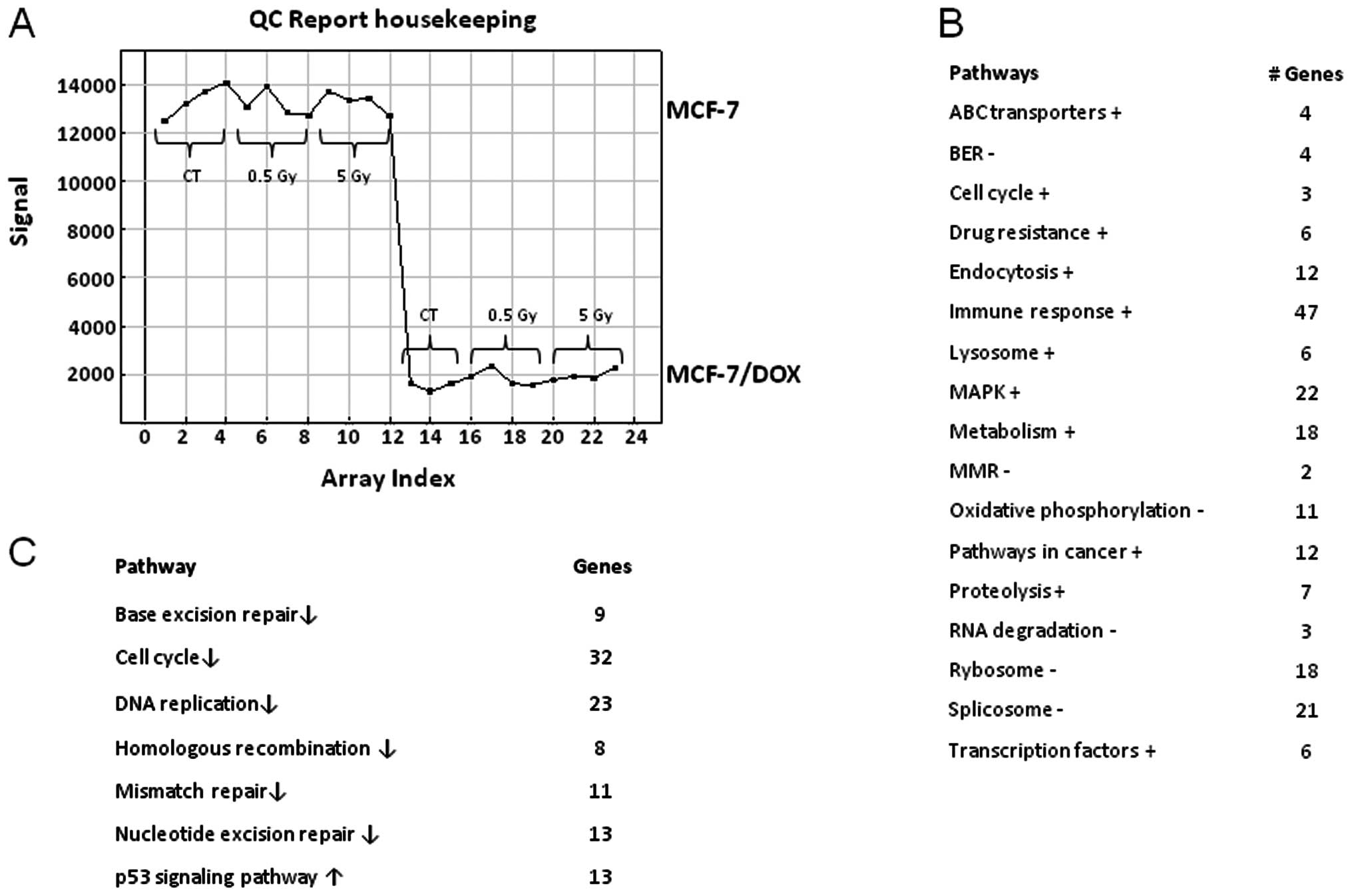 |
 |
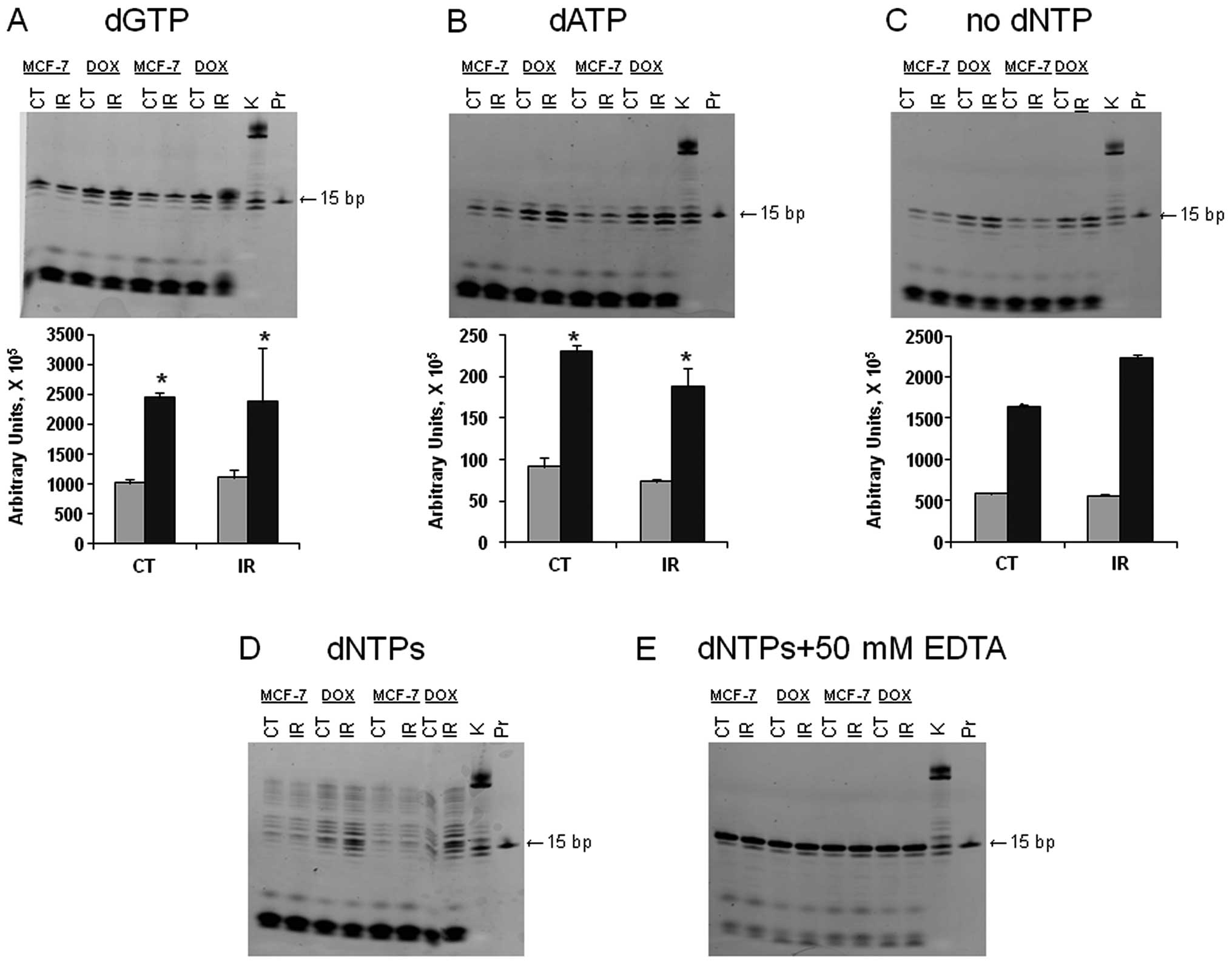 |
 |
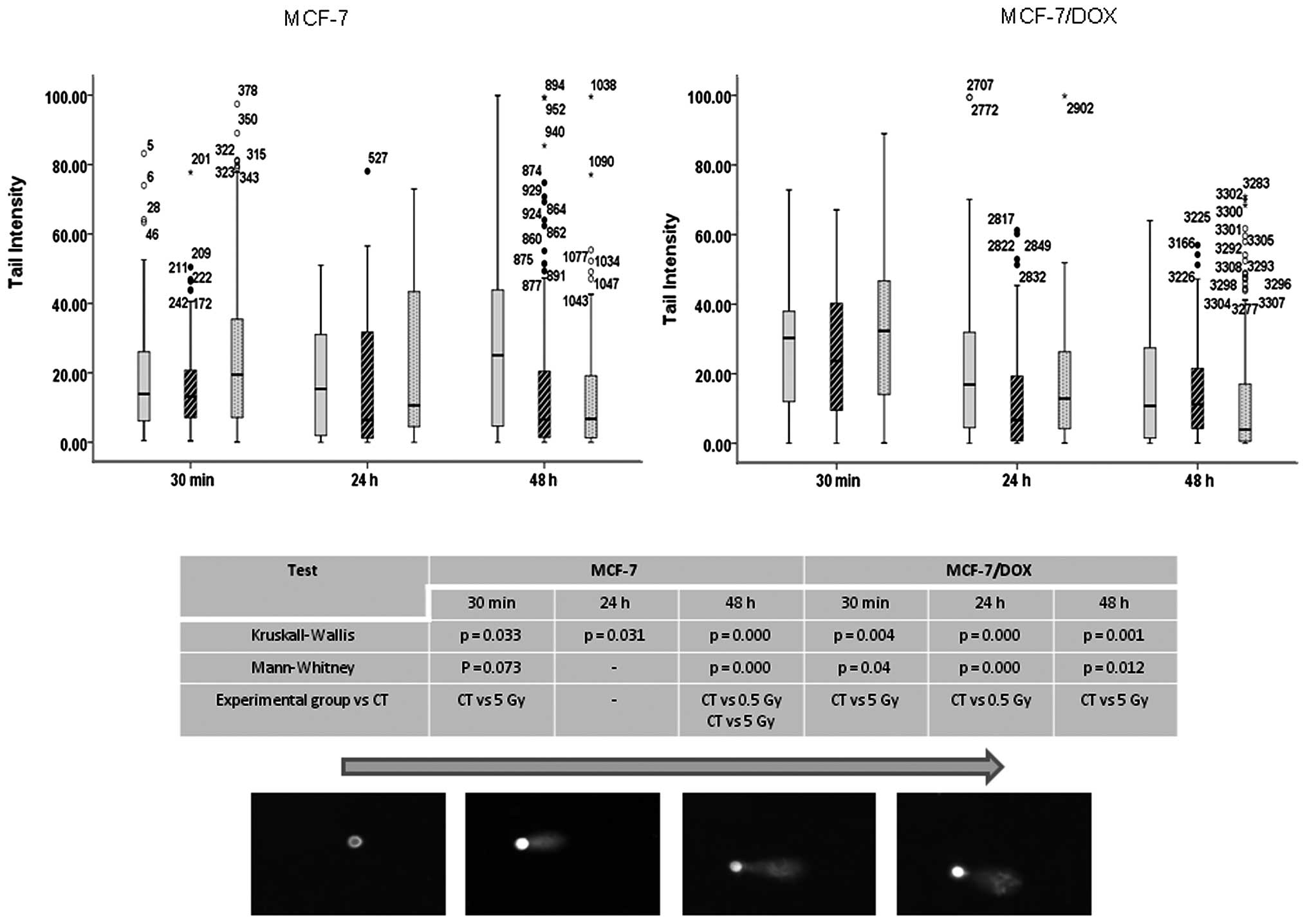 |
 |
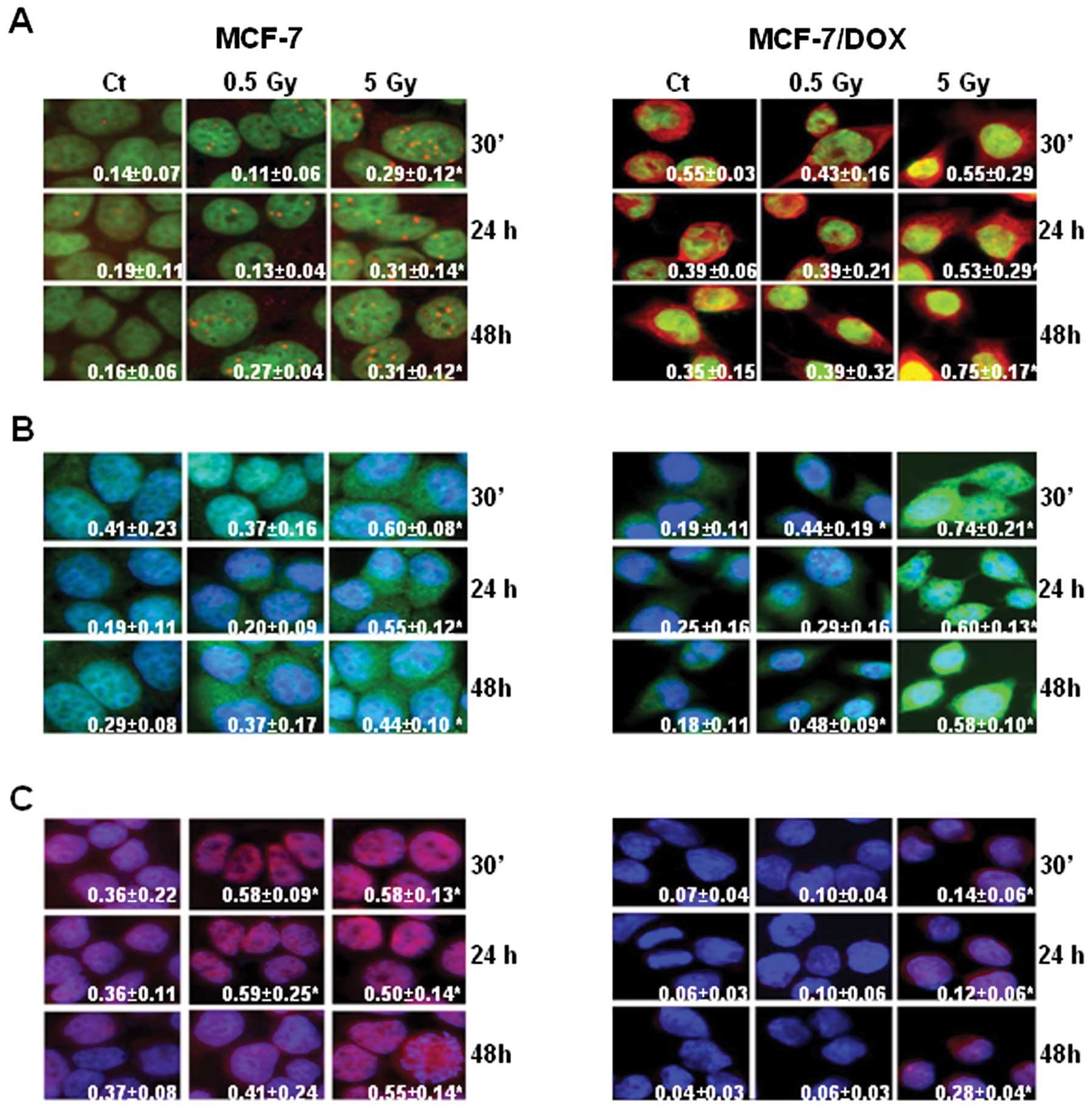 |
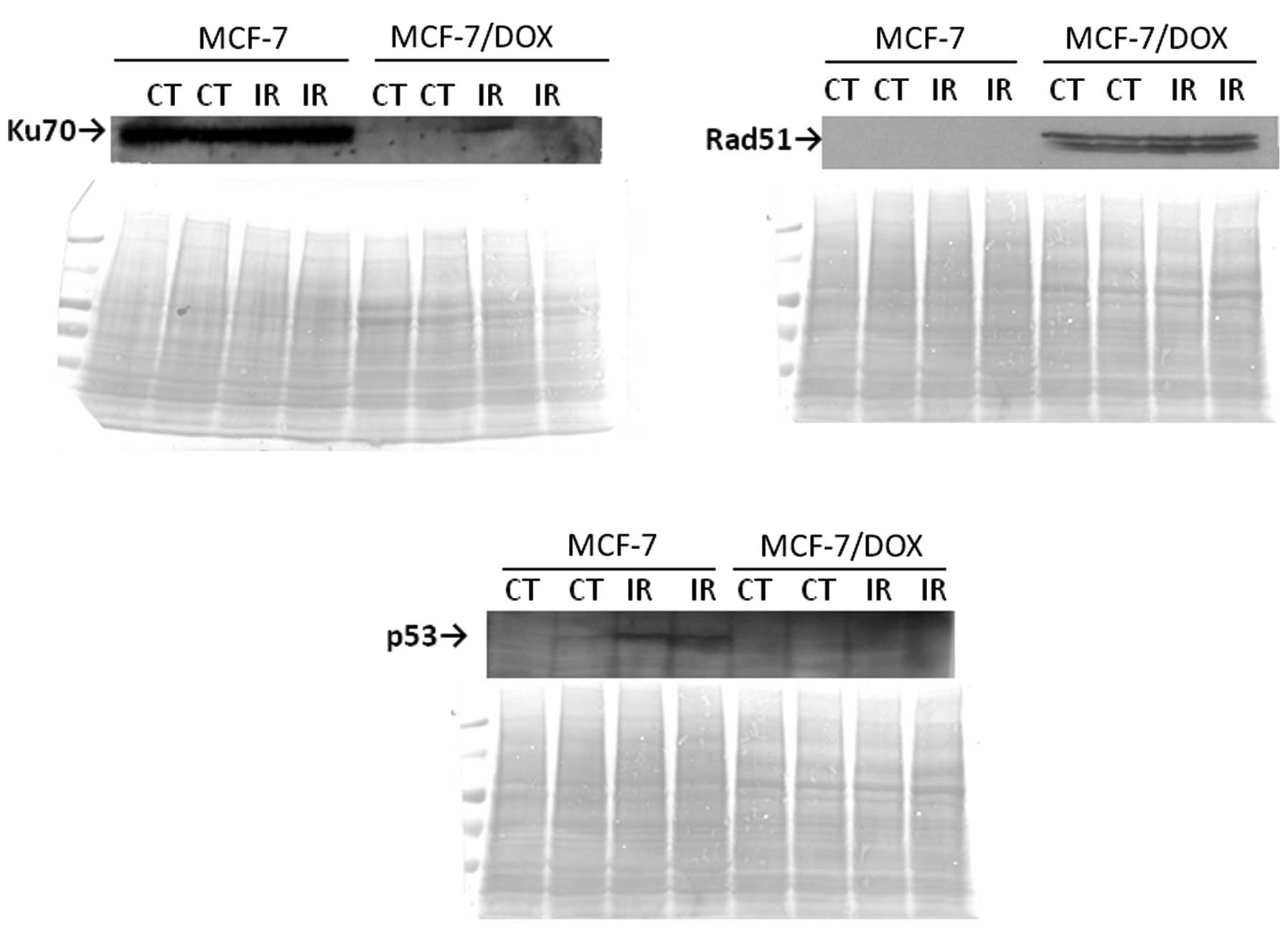 |
|
Guarneri V and Conte PF: The curability of breast cancer and the treatment of advanced disease. Eur J Nucl Med Mol Imaging. 31(Suppl 1): S149–S161. 2004. View Article : Google Scholar : PubMed/NCBI | |
|
Lehnert M: Clinical multidrug resistance in cancer: a multifactorial problem. Eur J Cancer. 32A:912–920. 1996. View Article : Google Scholar : PubMed/NCBI | |
|
Szakacs G, Paterson JK, Ludwig JA, Booth-Genthe C and Gottesman MM: Targeting multidrug resistance in cancer. Nat Rev Drug Discov. 5:219–234. 2006. View Article : Google Scholar : PubMed/NCBI | |
|
Fojo T: Multiple paths to a drug resistance phenotype: mutations, translocations, deletions and amplification of coding genes or promoter regions, epigenetic changes and microRNAs. Drug Resist Updat. 10:59–67. 2007. View Article : Google Scholar | |
|
O’Driscoll L and Clynes M: Molecular markers of multiple drug resistance in breast cancer. Chemotherapy. 52:125–129. 2006.PubMed/NCBI | |
|
Gottesman MM: Mechanisms of cancer drug resistance. Annu Rev Med. 53:615–627. 2002. View Article : Google Scholar : PubMed/NCBI | |
|
Pommier Y, Sordet O, Antony S, Hayward RL and Kohn KW: Apoptosis defects and chemotherapy resistance: molecular interaction maps and networks. Oncogene. 23:2934–2949. 2004. View Article : Google Scholar : PubMed/NCBI | |
|
Stavrovskaya AA: Cellular mechanisms of multidrug resistance of tumor cells. Biochemistry (Mosc). 65:95–106. 2000.PubMed/NCBI | |
|
Karran P: Mechanisms of tolerance to DNA damaging therapeutic drugs. Carcinogenesis. 22:1931–1937. 2001. View Article : Google Scholar : PubMed/NCBI | |
|
Rixe O and Fojo T: Is cell death a critical end point for anti-cancer therapies or is cytostasis sufficient? Clin Cancer Res. 13:7280–7287. 2007. View Article : Google Scholar : PubMed/NCBI | |
|
Hickman JA: Apoptosis and chemotherapy resistance. Eur J Cancer. 32A:921–926. 1996. View Article : Google Scholar : PubMed/NCBI | |
|
Gottesman MM and Ling V: The molecular basis of multidrug resistance in cancer: the early years of P-glycoprotein research. FEBS Lett. 580:998–1009. 2006.PubMed/NCBI | |
|
Modok S, Mellor HR and Callaghan R: Modulation of multidrug resistance efflux pump activity to overcome chemoresistance in cancer. Curr Opin Pharmacol. 6:350–354. 2006. View Article : Google Scholar : PubMed/NCBI | |
|
Coley HM: Mechanisms and strategies to overcome chemotherapy resistance in metastatic breast cancer. Cancer Treat Rev. 34:378–390. 2008. View Article : Google Scholar : PubMed/NCBI | |
|
Gonzalez-Angulo AM, Morales-Vasquez F and Hortobagyi GN: Overview of resistance to systemic therapy in patients with breast cancer. Adv Exp Med Biol. 608:1–22. 2007. View Article : Google Scholar : PubMed/NCBI | |
|
Petrelli A and Giordano S: From single- to multi-target drugs in cancer therapy: when aspecificity becomes an advantage. Curr Med Chem. 15:422–432. 2008. View Article : Google Scholar : PubMed/NCBI | |
|
Chekhun VF, Lukyanova NY, Kovalchuk O, Tryndyak VP and Pogribny IP: Epigenetic profiling of multidrug-resistant human MCF-7 breast adenocarcinoma cells reveals novel hyper- and hypomethylated targets. Mol Cancer Ther. 6:1089–1098. 2007. View Article : Google Scholar : PubMed/NCBI | |
|
Dean-Colomb W and Esteva FJ: Emerging agents in the treatment of anthracycline- and taxane-refractory metastatic breast cancer. Semin Oncol. 35:S31–S40. 2008. View Article : Google Scholar : PubMed/NCBI | |
|
Ozols RF, Masuda H and Hamilton TC: Mechanisms of cross-resistance between radiation and antineoplastic drugs. NCI Monogr. 159–165. 1988.PubMed/NCBI | |
|
Shimm DS, Olson S and Hill AB: Radiation resistance in a multidrug resistant human T-cell leukemia line. Int J Radiat Oncol Biol Phys. 15:931–936. 1988. View Article : Google Scholar : PubMed/NCBI | |
|
Belli JA: Interaction between radiation and drug damage in mammalian cells. IV. Radiation response of adriamycin-resistant V79 cells. Radiat Res. 119:88–100. 1989. View Article : Google Scholar : PubMed/NCBI | |
|
Lehnert S, Greene D and Batist G: Radiation response of drug-resistant variants of a human breast cancer cell line. Radiat Res. 118:568–580. 1989. View Article : Google Scholar : PubMed/NCBI | |
|
Lehnert S, Greene D and Batist G: Radiation response of drug-resistant variants of a human breast cancer cell line: the effect of glutathione depletion. Radiat Res. 124:208–215. 1990. View Article : Google Scholar : PubMed/NCBI | |
|
Alaoui-Jamali MA, Batist G and Lehnert S: Radiation-induced damage to DNA in drug- and radiation-resistant sublines of a human breast cancer cell line. Radiat Res. 129:37–42. 1992. View Article : Google Scholar : PubMed/NCBI | |
|
Miller PR, Hill AB, Slovak ML and Shimm DS: Radiation resistance in a doxorubicin-resistant human fibrosarcoma cell line. Am J Clin Oncol. 15:216–221. 1992. View Article : Google Scholar : PubMed/NCBI | |
|
Zhang Y, Sweet KM, Sognier MA and Belli JA: Interaction between radiation and drug damage in mammalian cells. VI. Radiation and doxorubicin age-response function of doxorubicin-sensitive and -resistant Chinese hamster cells. Radiat Res. 132:105–111. 1992. View Article : Google Scholar | |
|
Lehnert S, Vestergaard J, Batist G and Aloui-Jamali MA: Radiation resistance in a melphalan-resistant subline of a rat mammary carcinoma. Radiat Res. 139:232–239. 1994. View Article : Google Scholar : PubMed/NCBI | |
|
Liang K, Lu Y, Jin W, Ang KK, Milas L and Fan Z: Sensitization of breast cancer cells to radiation by trastuzumab. Mol Cancer Ther. 2:1113–1120. 2003.PubMed/NCBI | |
|
Koukourakis MI, Koukouraki S, Giatromanolaki A, et al: Liposomal doxorubicin and conventionally fractionated radiotherapy in the treatment of locally advanced non-small-cell lung cancer and head and neck cancer. J Clin Oncol. 17:3512–3521. 1999.PubMed/NCBI | |
|
Gewirtz DA: Growth arrest and cell death in the breast tumor cell in response to ionizing radiation and chemotherapeutic agents which induce DNA damage. Breast Cancer Res Treat. 62:223–235. 2000. View Article : Google Scholar : PubMed/NCBI | |
|
Reinhold WC, Kouros-Mehr H, Kohn KW, et al: Apoptotic susceptibility of cancer cells selected for camptothecin resistance: gene expression profiling, functional analysis, and molecular interaction mapping. Cancer Res. 63:1000–1011. 2003. | |
|
Kovalchuk O, Filkowski J, Meservy J, et al: Involvement of microRNA-451 in resistance of the MCF-7 breast cancer cells to chemotherapeutic drug doxorubicin. Mol Cancer Ther. 7:2152–2159. 2008. View Article : Google Scholar : PubMed/NCBI | |
|
Huang da W, Sherman BT and Lempicki RA: Systematic and integrative analysis of large gene lists using DAVID bioinformatics resources. Nat Protoc. 4:44–57. 2009.PubMed/NCBI | |
|
Huang da W, Sherman BT and Lempicki RA: Bioinformatics enrichment tools: paths toward the comprehensive functional analysis of large gene lists. Nucleic Acids Res. 37:1–13. 2009.PubMed/NCBI | |
|
Pfaffl MW: A new mathematical model for relative quantification in real-time RT-PCR. Nucleic Acids Res. 29:e452001. View Article : Google Scholar : PubMed/NCBI | |
|
Tryndyak VP, Kovalchuk O and Pogribny IP: Loss of DNA methylation and histone H4 lysine 20 trimethylation in human breast cancer cells is associated with aberrant expression of DNA methyltransferase 1, Suv4-20h2 histone methyltransferase and methyl-binding proteins. Cancer Biol Ther. 5:65–70. 2006. View Article : Google Scholar | |
|
Gening LV, Petrochenkov AN, Reshetnyak AB, Andreeva LE and Tarantul VZ: DNA polymerase iota-like activity in crude cell extracts of different mouse organs. Biochemistry (Mosc). 69:435–440. 2004. View Article : Google Scholar : PubMed/NCBI | |
|
Olive PL and Banath JP: The comet assay: a method to measure DNA damage in individual cells. Nat Protoc. 1:23–29. 2006. View Article : Google Scholar : PubMed/NCBI | |
|
Tice RR and Strauss GH: The single cell gel electrophoresis/comet assay: a potential tool for detecting radiation-induced DNA damage in humans. Stem Cells. 13(Suppl 1): 207–214. 1995.PubMed/NCBI | |
|
Sedelnikova OA and Bonner WM: GammaH2AX in cancer cells: a potential biomarker for cancer diagnostics, prediction and recurrence. Cell Cycle. 5:2909–2913. 2006. View Article : Google Scholar : PubMed/NCBI | |
|
Carpenter AE, Jones TR, Lamprecht MR, et al: CellProfiler: image analysis software for identifying and quantifying cell phenotypes. Genome Biol. 7:R1002006. View Article : Google Scholar : PubMed/NCBI | |
|
Lamprecht MR, Sabatini DM and Carpenter AE: CellProfiler: free, versatile software for automated biological image analysis. Biotechniques. 42:71–75. 2007. View Article : Google Scholar : PubMed/NCBI | |
|
Bebenek K and Kunkel TA: Functions of DNA polymerases. Adv Protein Chem. 69:137–165. 2004. View Article : Google Scholar | |
|
Shcherbakova PV, Bebenek K and Kunkel TA: Functions of eukaryotic DNA polymerases. Sci Aging Knowledge Environ 2003. RE32003.PubMed/NCBI | |
|
Vermes I, Haanen C, Steffens-Nakken H and Reutelingsperger C: A novel assay for apoptosis. Flow cytometric detection of phosphatidylserine expression on early apoptotic cells using fluorescein labelled Annexin V. J Immunol Methods. 184:39–51. 1995. View Article : Google Scholar | |
|
Little JB: Radiation carcinogenesis. Carcinogenesis. 21:397–404. 2000. View Article : Google Scholar | |
|
Huang L, Snyder AR and Morgan WF: Radiation-induced genomic instability and its implications for radiation carcinogenesis. Oncogene. 22:5848–5854. 2003. View Article : Google Scholar : PubMed/NCBI | |
|
Bonner WM, Redon CE, Dickey JS, et al: GammaH2AX and cancer. Nat Rev Cancer. 8:957–967. 2008. View Article : Google Scholar : PubMed/NCBI | |
|
Olive PL: DNA damage and repair in individual cells: applications of the comet assay in radiobiology. Int J Radiat Biol. 75:395–405. 1999. View Article : Google Scholar : PubMed/NCBI | |
|
West SC: Molecular views of recombination proteins and their control. Nat Rev Mol Cell Biol. 4:435–445. 2003. View Article : Google Scholar : PubMed/NCBI | |
|
McGlynn P and Lloyd RG: Recombinational repair and restart of damaged replication forks. Nat Rev Mol Cell Biol. 3:859–870. 2002. View Article : Google Scholar : PubMed/NCBI | |
|
Helleday T: Pathways for mitotic homologous recombination in mammalian cells. Mutat Res. 532:103–115. 2003. View Article : Google Scholar : PubMed/NCBI | |
|
Hoeijmakers JH: DNA repair mechanisms. Maturitas. 38:17–23. 2001. View Article : Google Scholar : PubMed/NCBI | |
|
Chowdhury D, Keogh MC, Ishii H, Peterson CL, Buratowski S and Lieberman J: gamma-H2AX dephosphorylation by protein phosphatase 2A facilitates DNA double-strand break repair. Mol Cell. 20:801–809. 2005. View Article : Google Scholar : PubMed/NCBI | |
|
Lundin C, Schultz N, Arnaudeau C, Mohindra A, Hansen LT and Helleday T: RAD51 is involved in repair of damage associated with DNA replication in mammalian cells. J Mol Biol. 328:521–535. 2003. View Article : Google Scholar : PubMed/NCBI | |
|
Hoeijmakers JH: Genome maintenance mechanisms for preventing cancer. Nature. 411:366–374. 2001. View Article : Google Scholar : PubMed/NCBI | |
|
Jin S and Weaver DT: Double-strand break repair by Ku70 requires heterodimerization with Ku80 and DNA binding functions. EMBO J. 16:6874–6885. 1997. View Article : Google Scholar : PubMed/NCBI | |
|
Fornari FA, Randolph JK, Yalowich JC, Ritke MK and Gewirtz DA: Interference by doxorubicin with DNA unwinding in MCF-7 breast tumor cells. Mol Pharmacol. 45:649–656. 1994.PubMed/NCBI | |
|
Fortune JM and Osheroff N: Topoisomerase II as a target for anticancer drugs: when enzymes stop being nice. Prog Nucleic Acid Res Mol Biol. 64:221–253. 2000. View Article : Google Scholar : PubMed/NCBI | |
|
Khimani AH, Mhashilkar AM, Mikulskis A, et al: Housekeeping genes in cancer: normalization of array data. Biotechniques. 38:739–745. 2005. View Article : Google Scholar : PubMed/NCBI | |
|
Rubie C, Kempf K, Hans J, et al: Housekeeping gene variability in normal and cancerous colorectal, pancreatic, esophageal, gastric and hepatic tissues. Mol Cell Probes. 19:101–109. 2005. View Article : Google Scholar : PubMed/NCBI | |
|
Barnard GF, Staniunas RJ, Bao S, et al: Increased expression of human ribosomal phosphoprotein P0 messenger RNA in hepatocellular carcinoma and colon carcinoma. Cancer Res. 52:3067–3072. 1992.PubMed/NCBI | |
|
Henry JL, Coggin DL and King CR: High-level expression of the ribosomal protein L19 in human breast tumors that overexpress erbB-2. Cancer Res. 53:1403–1408. 1993.PubMed/NCBI | |
|
Lukyanova NY, Rusetskya NV, Tregubova NA and Chekhun VF: Molecular profile and cell cycle in MCF-7 cells resistant to cisplatin and doxorubicin. Exp Oncol. 31:87–91. 2009.PubMed/NCBI | |
|
Gyorffy B, Serra V, Jurchott K, et al: Prediction of doxorubicin sensitivity in breast tumors based on gene expression profiles of drug-resistant cell lines correlates with patient survival. Oncogene. 24:7542–7551. 2005. View Article : Google Scholar : PubMed/NCBI | |
|
Huang J, Tan PH, Thiyagarajan J and Bay BH: Prognostic significance of glutathione S-transferase-pi in invasive breast cancer. Mod Pathol. 16:558–565. 2003. View Article : Google Scholar : PubMed/NCBI | |
|
Saleh EM, El-Awady RA, Abdel Alim MA and Abdel Wahab AH: Altered expression of proliferation-inducing and proliferation-inhibiting genes might contribute to acquired doxorubicin resistance in breast cancer cells. Cell Biochem Biophys. 55:95–105. 2009. View Article : Google Scholar | |
|
Miyara H, Hida T, Nishida K, et al: Modification of chemoradiosensitivity of a human lung cancer cell line by introduction of the glutathione S-transferase pi gene. Jpn J Clin Oncol. 26:1–5. 1996. View Article : Google Scholar : PubMed/NCBI | |
|
Harper ME, Antoniou A, Villalobos-Menuey E, et al: Characterization of a novel metabolic strategy used by drug-resistant tumor cells. FASEB J. 16:1550–1557. 2002. View Article : Google Scholar : PubMed/NCBI | |
|
Diehn M, Cho RW, Lobo NA, et al: Association of reactive oxygen species levels and radioresistance in cancer stem cells. Nature. 458:780–783. 2009. View Article : Google Scholar : PubMed/NCBI | |
|
Kang JH, Song KH, Jeong KC, et al: Involvement of Cox-2 in the metastatic potential of chemotherapy-resistant breast cancer cells. BMC Cancer. 11:3342011. View Article : Google Scholar : PubMed/NCBI | |
|
Mihich E: On the immunomodulating effects of anti-cancer drugs and their therapeutic exploitation. Jpn J Clin Oncol. 30:469–471. 2000. View Article : Google Scholar : PubMed/NCBI | |
|
Ehrke MJ, Verstovsek S, Zaleskis G, et al: Specific anti-EL4-lymphoma immunity in mice cured 2 years earlier with doxorubicin and interleukin-2. Cancer Immunol Immunother. 42:221–230. 1996.PubMed/NCBI | |
|
Cahill DP, Lengauer C, Yu J, et al: Mutations of mitotic checkpoint genes in human cancers. Nature. 392:300–303. 1998. View Article : Google Scholar : PubMed/NCBI | |
|
Nguyen HG, Makitalo M, Yang D, Chinnappan D, St Hilaire C and Ravid K: Deregulated Aurora-B induced tetraploidy promotes tumorigenesis. FASEB J. 23:2741–2748. 2009. View Article : Google Scholar : PubMed/NCBI | |
|
Sak A, Stuschke M, Groneberg M, Kubler D, Pottgen C and Eberhardt WE: Inhibiting the aurora B kinase potently suppresses repopulation during fractionated irradiation of human lung cancer cell lines. Int J Radiat Oncol Biol Phys. 84:492–499. 2012. View Article : Google Scholar : PubMed/NCBI | |
|
Liebermann DA, Tront JS, Sha X, Mukherjee K, Mohamed-Hadley A and Hoffman B: Gadd45 stress sensors in malignancy and leukemia. Crit Rev Oncog. 16:129–140. 2011. View Article : Google Scholar : PubMed/NCBI | |
|
Kunkel TA and Burgers PM: Dividing the workload at a eukaryotic replication fork. Trends Cell Biol. 18:521–527. 2008. View Article : Google Scholar : PubMed/NCBI | |
|
Matsuda T, van de Berg BJ, Bebenek K, Osheroff WP, Wilson SH and Kunkel TA: The base substitution fidelity of DNA polymerase beta-dependent single nucleotide base excision repair. J Biol Chem. 278:25947–25951. 2003. View Article : Google Scholar : PubMed/NCBI | |
|
Kunkel TA, Pavlov YI and Bebenek K: Functions of human DNA polymerases eta, kappa and iota suggested by their properties, including fidelity with undamaged DNA templates. DNA Repair (Amst). 2:135–149. 2003. View Article : Google Scholar : PubMed/NCBI | |
|
Beard WA, Shock DD, Vande Berg BJ and Wilson SH: Efficiency of correct nucleotide insertion governs DNA polymerase fidelity. J Biol Chem. 277:47393–47398. 2002. View Article : Google Scholar | |
|
Goodman MF and Tippin B: Sloppier copier DNA polymerases involved in genome repair. Curr Opin Genet Dev. 10:162–168. 2000. View Article : Google Scholar : PubMed/NCBI | |
|
Taylor ST, Hickman JA and Dive C: Survival signals within the tumour microenvironment suppress drug-induced apoptosis: lessons learned from B lymphomas. Endocr Relat Cancer. 6:21–23. 1999. View Article : Google Scholar : PubMed/NCBI | |
|
Banath JP, Macphail SH and Olive PL: Radiation sensitivity, H2AX phosphorylation, and kinetics of repair of DNA strand breaks in irradiated cervical cancer cell lines. Cancer Res. 64:7144–7149. 2004. View Article : Google Scholar : PubMed/NCBI | |
|
Jeggo P and Lobrich M: Radiation-induced DNA damage responses. Radiat Prot Dosimetry. 122:124–127. 2006. View Article : Google Scholar : PubMed/NCBI | |
|
Baumann P and West SC: Role of the human RAD51 protein in homologous recombination and double-stranded-break repair. Trends Biochem Sci. 23:247–251. 1998. View Article : Google Scholar : PubMed/NCBI | |
|
Dudas A and Chovanec M: DNA double-strand break repair by homologous recombination. Mutat Res. 566:131–167. 2004. View Article : Google Scholar : PubMed/NCBI | |
|
Benson FE, Baumann P and West SC: Synergistic actions of Rad51 and Rad52 in recombination and DNA repair. Nature. 391:401–404. 1998. View Article : Google Scholar : PubMed/NCBI | |
|
Goodarzi AA, Block WD and Lees-Miller SP: The role of ATM and ATR in DNA damage-induced cell cycle control. Prog Cell Cycle Res. 5:393–411. 2003.PubMed/NCBI | |
|
Goodarzi AA, Jonnalagadda JC, Douglas P, et al: Auto-phosphorylation of ataxia-telangiectasia mutated is regulated by protein phosphatase 2A. EMBO J. 23:4451–4461. 2004. View Article : Google Scholar : PubMed/NCBI | |
|
Alexander A, Cai SL, Kim J, et al: ATM signals to TSC2 in the cytoplasm to regulate mTORC1 in response to ROS. Proc Natl Acad Sci USA. 107:4153–4158. 2010. View Article : Google Scholar : PubMed/NCBI | |
|
Harris AL: DNA repair: relationship to drug and radiation resistance, metastasis and growth factors. Int J Radiat Biol Relat Stud Phys Chem Med. 48:675–690. 1985. View Article : Google Scholar : PubMed/NCBI |









